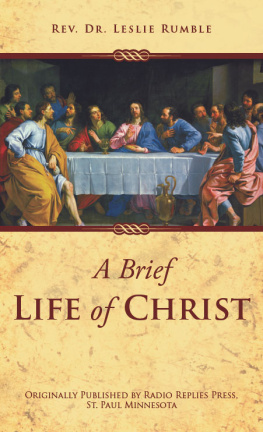
Copyright 2014 by Craig Turner.
All rights reserved. With the exception of short excerpts used in articles and critical review, no part of this work may be reproduced, transmitted, or stored in any form whatsoever, printed or electronic, without the prior written permission of the publisher.
Cataloging-in-Publication data on file with the Library of Congress.
Typeset by Lapiz Digital Services.
Cover design by Caroline Kiser.
Cover image: Bloch, Carl (1834-90). The Visitation, oil on canvas, (Frederiksborg Castle, Hillerod, Denmark).
ISBN: 978-0-89555-717-9
Published in the United States by
TAN Books
P.O. Box 410487
Charlotte, NC 28241
www.TANBooks.com
Printed and Bound in the United States of America.
A NOTE TO THE READER
The primary texts used in this book from which the locutions were taken include:
The Spiritual Doctrine of St. Catherine of Genoa , by Saint Catherine of Genoa and Don Cattaneo Marabotto. TAN Books, 1989. (CoG)
The Autobiography of Saint Margaret Mary , translated by the Sisters of the Visitation (Partridge Green, Horsham, West Sussex). TAN Books, 1986. (MMA)
Saint Teresa of Avila, Collected Works, Vol. 1 , translated by Kieran Kavanaugh, O.C.D. and Otilio Rodriguez, O.C.D. ICS (Institute of Carmelite Studies) Publications, 1976. (TA)
The Life and Revelations of St. Gertrude the Great (Books IV), by Saint Gertrude the Great and the Religious of her monastery. TAN Books, 2009. (GG)
Quotes were used as they appear in the original works with the exception of some modernization of the usage of words. For example, thee and thy were updated to read you and your.
ACKNOWLEDGMENTS
A NUMBER of different people deserve credit for their invaluable assistance in the production of this book. Among those are the people who gave time and effort without pay for compiling quotes from their sources and writing the biographies of their particular saints. These people include Fae Presley (Saint Teresa of Avila), Michael Seagriff (Saint Margaret Mary Alacoque), Tom Sherry (Saint Catherine of Genoa), and Laura Brestovansky (Saint Gertrude the Great).
Another source of inspiration and help was Bob French, who assisted in editing and gave recommendations when needed. I am also indebted to the staff at TAN Books, and to Todd Aglialoro in particular, for guidance and suggestions when difficult choices were necessary. Finally, I would like to thank the Blessed Virgin Mary for her prayers and assistance, sometimes felt and always appreciated, in helping bring this book to completion.
CONTENTS
INTRODUCTION
I WILL never forget the first time I heard that a person can hear the voice of God. In 1992, I was twenty-nine years old and in the midst of a major conversion experience that would lead me away from my strongly held atheistic convictions and into the Catholic Church. I had prided myself in my skills at debating and oratory, and had convinced some, perhaps many, that God was merely a figment of ones imagination. I was so unschooled in the topic of religion during those early months of my conversion that I didnt even know the meaning of the word grace, and was taught its meaning while sitting in the office of a holy priest, the first Catholic cleric I would meet as an adult. As my conversion took hold during the fall of that year, a good friend introduced me to the life of Saint Francis of Assisi, the renowned stigmatist who gave up everything he ownedincluding the clothes on his back, which he returned to his fatherto be closer to God.
The story about Saint Francis that moved me is one that has been retold many times. The story began when Francis traveled along a worn path in the Umbrian hills of Italy to pray at the church of San Damiano, a crumbling relic of stone and mortar. The church was so dilapidated and poor, that the only adornments in the building were an altar and a crucifix. While inside the church, kneeling before the large Byzantine crucifix, he distinctly heard the words, Francis, Francis, rebuild my church, for as you can see it is falling down. Three times the youthful Francis heard this sentence in his heart, and when he came to himself after this experience, he first gave back to his father all he owed him, and then returned to rebuild the little decrepit church of San Damiano, overgrown with brambles and weeds. It was a difficult but glorious undertaking that took months to complete. Francis worked by day and slept in the evening on the stone floor of the church with a tattered roof, peering out through the missing timbers at the starry Italian sky before finally dozing off to sleep. When his work at San Damiano was complete, he continued to rebuild, but this time he took on the massive structure of the Catholic Church, considerably larger in both size and complexity. He worked in this vineyard until he died: the founder of a new religious order, a worker of miracles, and a bearer of the stigmata, the wounds of Christ.
During his years as a laborer for Christ, he continued to hear the voice of his master, who guarded him from temptations and directed his soul toward holiness. In one inspiring episode, Francis was tempted to give up his hard labors, being shown a false image of what he would become if he did not cease his fasting, mortifications, and work:
The ancient enemy strove to turn [Francis] away from his resolution, putting the image of a hunchback woman of Assisi in his mind, and warning him that if he did not abandon what he had undertaken, he would become like her. But Our Lord comforted him, and he heard the words, Francis, put the bitter ahead of the sweet, and despise yourself, if you would know me.
The Golden Legend
What is astonishing about the locution Francis received is that Saint Bridget of Sweden, who lived more than a hundred years later, received a nearly identical locution from the Virgin Mary:
Which of the saints, Mary said, had the sweetness of the Spirit without first experiencing bitterness? Therefore, one who craves sweetness must not flee from things that are bitter.
Life and Selected Revelations
(Fifth Book, Fifth Interrogation)
Our Lord will repeat his messages through the centuries to those who dare to listen, and while speaking to his servants, will tell them either the exact message again, or a similar communication that reveals even more. Consider the following locution received by Saint Rose of Lima, the sixteenth-century hermit of South America who is Patroness of the Americas:
Our Lord and Savior lifted up his voice and said with incomparable majesty, Let all men know that without the burden of afflictions, it is impossible to reach the height of grace. Let them know that the gift of grace increases as the struggle increases.
Jesus statement that one should not flee bitterness if one is to experience the sweetness of the Spirit becomes even more imperative: that to receive the gift of grace one must bear the burden of afflictions. For those who live lives of comfort, this statement can be a terrible thorn. But for those who suffer, the sweetness of these words can be the most succulent of nectars.
Our story, however, is not about these venerable examples of holinessFrancis of Assisi, Bridget of Sweden and Rose of Limabut about saints whose lives were equally outstanding. In chronological order, they are: Saint Gertrude the Great (12561302), Saint Catherine of Genoa (14471510), Saint Teresa of Avila (15151582) and Saint Margaret Mary Alacoque (16471690).
These four saints received messages from Jesus that are of inestimable value to Christians seeking holiness. When the faithful meditate devoutly upon these locutions, and, with Gods grace, apply the wisdom found therein to their daily lives, great fruit is sure to follow.
Next page







